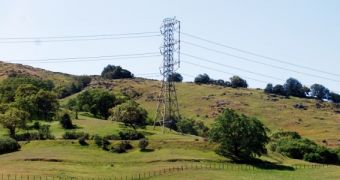According to a new study conducted by researchers at the University College London (UCL), it would appear that animals see power lines as either glowing or flashing bands across the horizon. If this finding is confirmed, then this would mean that power lines dotting the landscape around the world are having a significant influence on wildlife movement and reproduction patterns.
The work, conducted by vision expert, professor Glen Jeffrey, argues that both pylons and wires have similar effects on wildlife. This conclusion is based on an in-depth study of animal species capable of perceiving ultraviolet radiations. The human eye is not sensitive to light emitted in this portion of the electromagnetic spectrum, but the majority of wildlife species are.
Previous studies conducted in the wild have revealed that some animal species treat power lines and pylons as impassable physical barriers, even though there are no obstacles on the surface preventing their passage. Scientists have been trying to figure out the origins of such behaviors for a long time, and it would now appear that light is the answer to the riddle, The Guardian reports.
Among the animals that have thus far been confirmed to have UV-sensitive eyes researchers mention cats, dogs, rats, bats, cattle, red pandas, hedgehogs, okapi, and reindeer. The latter are particularly sensitive to this type of light, since their eyes exhibit special adaptations to keep the animal competitive during the dark winters that roam the Arctic.
“It was a big surprise but we now think the majority of animals can see UV light. There is no reason why this phenomenon is not occurring around the world,” Jeffery explains “The flashes occur at random in time and space, so the power lines are not grey and passive, but seen as lines of light flashing,” adds Dr. Nicolas Tyler.
The expert holds an appointment as an ecologist with the UIT Arctic University of Norway and was a member of the research team that conducted the new investigation. Tyler believes that this study has important implications for conservation efforts worldwide, as well as for our scientific understanding of modern habitat and ecosystem dynamics.
“The loss and fragmentation of habitat by infrastructure is the principle global threat to biodiversity – it is absolutely major. Roads have always got particular attention but this will push power lines right up the list of offenders,” the expert adds. A paper detailing the findings is published in the current issue of the journal Conservation Biology.
Tyler adds that the UV flashes the animals see occur at random intervals in both time and space. As such, the power lines do not appear gray and passive – as current impact studies indicate – but rather resemble flashing bands of light. Understandably, numerous species are frightened to go anywhere near these structures.

 14 DAY TRIAL //
14 DAY TRIAL //